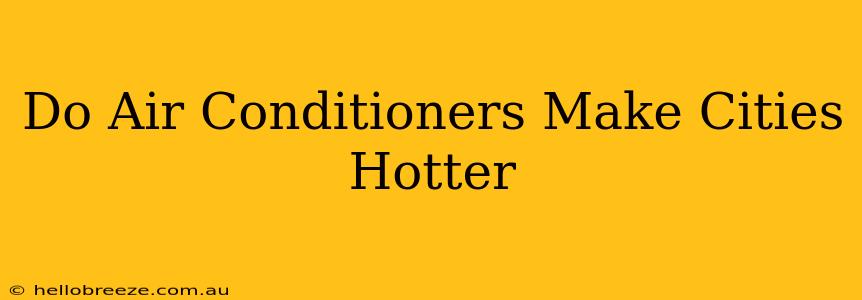Do Air Conditioners Make Cities Hotter? Unpacking the Urban Heat Island Effect
The question of whether air conditioners contribute to the urban heat island effect is complex, and the short answer is: it's complicated. While air conditioners offer crucial comfort and protection from heatstroke, their operation does release heat into the environment. Let's delve deeper into the nuances of this issue.
Understanding the Urban Heat Island Effect
Cities are demonstrably hotter than surrounding rural areas. This phenomenon, known as the urban heat island (UHI) effect, is driven by several factors, including:
- Dark surfaces: Concrete, asphalt, and dark-colored buildings absorb and retain significantly more heat than vegetation and natural surfaces.
- Lack of vegetation: Trees and plants provide shade and cool the air through evapotranspiration (the process of water evaporating from leaves). Cities often lack the extensive vegetation cover found in rural areas.
- Human activities: Industrial processes, vehicle emissions, and even human bodies generate heat.
- Air conditioning: This is where the debate comes in. While air conditioners cool the inside of buildings, the heat they remove is expelled outside.
How Air Conditioners Contribute to the Heat
The heat expelled by air conditioners is a significant contributor to the overall ambient temperature, particularly in densely populated urban areas. Consider this:
- Heat rejection: Air conditioners don't simply make heat disappear; they transfer it from inside a building to outside. This added heat contributes directly to the UHI effect.
- Increased energy consumption: The greater the demand for cooling, the more energy power plants need to generate, leading to further heat emissions. These power plants often rely on fossil fuels, exacerbating the problem.
- Concentrated heat: Numerous air conditioners operating in close proximity within a city can create localized "heat pockets," significantly impacting microclimates within the urban landscape.
The Balancing Act: Benefits vs. Drawbacks
Despite the heat released, air conditioners play a vital role in public health and well-being, especially during heatwaves. They prevent heat-related illnesses and deaths, particularly among vulnerable populations. Completely abandoning air conditioning isn't a practical solution.
Mitigating the Impact: Solutions and Strategies
Rather than focusing on eliminating air conditioners, the focus should be on mitigating their impact on the UHI effect. Here are some strategies:
- Energy-efficient AC units: Investing in energy-efficient air conditioners reduces the amount of energy consumed and heat expelled. Look for units with high Energy Efficiency Ratio (EER) ratings.
- Green infrastructure: Increasing urban green spaces, planting trees, and using green roofs can significantly reduce the UHI effect by providing shade and promoting evapotranspiration.
- Improved building design: Designing buildings with passive cooling strategies, such as natural ventilation and shading, reduces reliance on air conditioning.
- Smart grids and demand response: Smart grids can optimize energy distribution and reduce peak demand, minimizing the overall energy consumption and heat generated by air conditioning systems.
Conclusion: A Complex Relationship
Air conditioners do contribute to the urban heat island effect by releasing heat into the environment. However, their benefits in protecting public health from heat-related illnesses outweigh the drawbacks. Focusing on energy efficiency, green infrastructure, and sustainable building design are crucial steps in mitigating the negative impacts of air conditioning on urban temperatures. The key is not eliminating air conditioning, but using it responsibly and sustainably.

